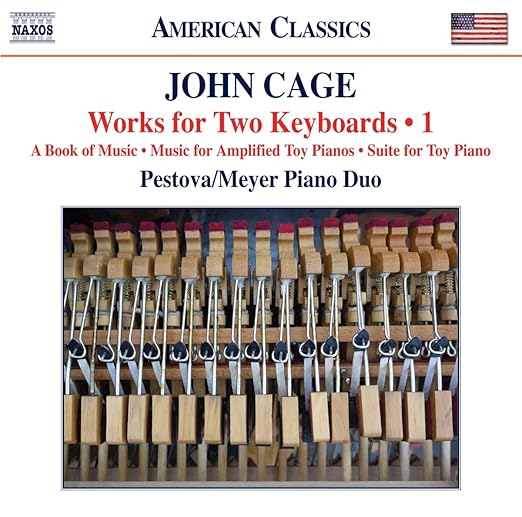- Download Suite For Toy Piano John Cage Sheet Music
- Download Suite For Toy Piano John Cage Full
- Download Suite For Toy Piano John Cage Free
Enter your keywords. Blog; Newsletter; Donate; Previous Entry; Next Entry. Listen to Cage: Suite for Toy Piano on Spotify. John Cage Single 2017 1 songs.
“Though originally made as a child’s toy, the toy piano has been used in serious classical and contemporary musical contexts. The most famous example is the “Suite for Toy Piano” (1948) by John Cage. Other works in classical music for the instrument include “Ancient Voices of Children” by George Crumb and a number of pieces by Mauricio Kagel. Steve Beresford has used toy pianos (along with many other toy instruments) in his improvised music.” From Wikipedia, the free encyclopedia
Silvia Corda plays also the toy piano and some other keyboard instruments such as indian harmonium, melodica, glockenspiel. Her repertoire includes composers like John Cage, Matthew McConnell, Karlheinz Essl and her own compositions and improvisations as well.
Tre Ritratti del Tempo was runner-up (2nd place) for 2013 UnCaged Call for Scores.
Silvia’s “The Root of the Wind” played by Mark Robson

“Quattro pensieri per il Nuovo Anno” played by Antonietta Loffredo (world premiere).
Monfalcone June 2nd 2014. Risuonanze – Incontri di Nuove Musiche.
“Nel succedersi degli istanti” played by Antonietta Loffredo (world premiere).
Monfalcone June 1st 2015. Risuonanze – Incontri di Nuove Musiche.

Download Suite For Toy Piano John Cage Sheet Music
Coming soon some other audio and video stuff!

John Cage (1912–1992, USA) – His initial education was at Los Angeles High School and then, for two years, at Pomona College, which he left in 1930. After a year in Europe dabbling in various arts, Cage came back to Los Angeles in 1931 and began to study composition. His first instruction came from Richard Buhling, and then Henry Cowell, Adolph Weiss and Arnold Schoenberg (in Los Angeles in 1934). Then he began working as a dance accompanist and teacher (UCLA, the Cornish School of the Arts in Seattle). It was here that he first met the dancer Merce Cunningham, with whom he would have a lifelong working relationship, being Musical Advisor for the Merce Cunningham Dance Company until his death. Through dance, Cage was also introduced to the idea of writing music for percussion ensemble, using dancers as musicians. In 1943, he moved to New York City, where his concerts featuring percussion instruments attracted attention, as also the idea of the prepared piano. Alongside this development, Cage was among the first composers to envisage the expansion of sonic possibilitiesimplied by electronic technologies (Imaginary Landscape no.1 in 1939). Towards the end of the 1940s Cage also started to develop anaesthetic of silence, because of his interest in Eastern philosophies, especially Zen Buddhism. The result was music derived, at least in part, from quasi-random decisions – chance operations. In 1952, at Black Mountain College, he presented a theatrical event considered by many to have been the preparation for the first happening.

Over the course of his career, Cage also worked increasingly in non-musical media, especially graphics, writing and poetry.
His disparate works include Bacchanale for prepared piano (1938), Imaginary Landscape No. 4 for 12 radios (1951), 4’ 33’’ (1952), Fontana Mix for tape (1958), HPSCHD for seven harpsichords, 51 tapes, and non-musical media (1969), Roaratorio (1979), Europeras 1-5 (1987-1991). His books include : Silence (1961), A Year from Monday (1967) and For the Birds (1981).
Cage was the recipient of many awards and honors, beginning in 1949 with a Guggenheim Fellowship and an Award from the National Academy of Arts and Letters. Cage was elected to the American Academy of Arts and Sciences in 1978, and was inducted into the 50-member American Academy of Arts and Letters in May, 1989.

Download Suite For Toy Piano John Cage Full
John Cage
Suite for Toy Piano (1948)
I.
II.
III.
IV.
V.
Download Suite For Toy Piano John Cage Free
Cage wrote his Suite for Toy Piano at Black Mountain College in North Carolina for Merce Cunningham’s Diversion. The suite is in 5 short, numbered movements. Obviously it employs a very limited gamut of tones: the nine white keys. It can ostensibly be played on virtually any toy piano, even one with painted black keys. The suite is one of Cage’s most charming and whimsical compositions. It is a humorous and ironic piece, giving exaggerated dynamics that can’t be realized (on a toy piano) from sffz to ppp.